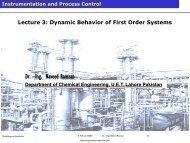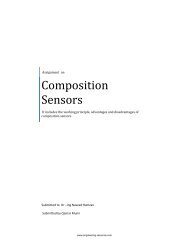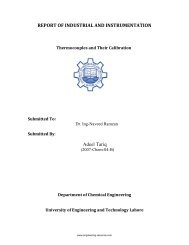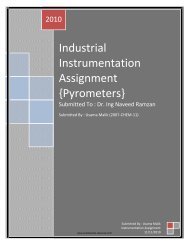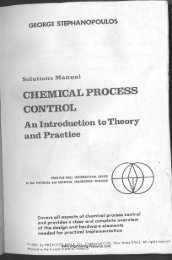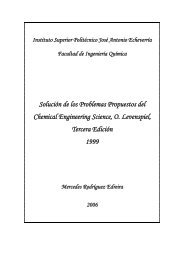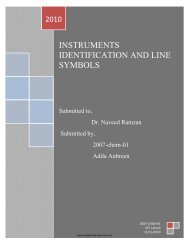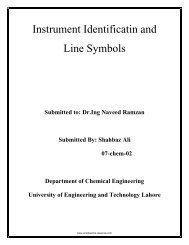Elastic Pressure Transducers - the engineering resource
Elastic Pressure Transducers - the engineering resource
Elastic Pressure Transducers - the engineering resource
Create successful ePaper yourself
Turn your PDF publications into a flip-book with our unique Google optimized e-Paper software.
2010<strong>Elastic</strong> <strong>Pressure</strong><strong>Transducers</strong>http://images.brighthub.com/5E/5/5E57FFD7F92397E13A98427699869325FESubmitted to:C6A811_small.jpgSubmitted By:Dr. ing Naveed RamzanWaseem Zia (2007-CHEM-15)www.<strong>engineering</strong>-<strong>resource</strong>.comCHEMICAL ENGINEERING DEPARTMENTUET Lahore, Pakistan10/31/2010
AbstractThis report describes <strong>the</strong> flexible pressure transducer (EPT). It involves <strong>the</strong> function principles,types of EPT and <strong>the</strong>ir use and applications. Merits and demerits of EPT are discussed along with<strong>the</strong>ir conditions of failures.But……………Instruments are always incorrect.www.<strong>engineering</strong>-<strong>resource</strong>.com
Contents1.<strong>Elastic</strong> <strong>Pressure</strong> Transducer ............................................................................................................... 11.1 Bellows ...................................................................................................................................... 11.2 Bourdon Tube Gauges ………………………………………...……………………………..3Common types of Bourdon Tube Gauges ……………………………………………...41.3 Diaphragm ................................................................................................................................ 52. <strong>Pressure</strong> Sensors Summary ............................................................................................................... 63. Functional Uses .................................................................................................................................. 74. Merits & Demerits……..………………………………………………………..……….…………. 75. Reference ……………………………………………………………………………………………..8www.<strong>engineering</strong>-<strong>resource</strong>.com
1. <strong>Elastic</strong> <strong>Pressure</strong> <strong>Transducers</strong><strong>Elastic</strong> Deformation 1 :This pressure sensing system is based on <strong>the</strong> idea that bending of flexible material is directly relative to <strong>the</strong>pressure being considered. There are mainly three sensor types that are used in this system of sensingpressure: Bourdon-tubes, diaphragms and bellows.Flexible Sensors:Most fluid pressure sensors are of <strong>the</strong> flexible type, where <strong>the</strong> fluid is enclosed in a small compartment with atleast one flexible wall. The pressure reading is <strong>the</strong>reby calculated by sensing <strong>the</strong> movement of this flexiblewall, resulting in ei<strong>the</strong>r a direct readout through suitable connections, or a transducer electrical signal.Flexible pressure sensors are sensitive; <strong>the</strong>y are commonly delicate and liable to throb, however. In addition,<strong>the</strong>y tend to be much more costly than manometers, and are <strong>the</strong>refore preferentially used for transmittingdetected data and sensing pressure differences. A broad diversity of flexible elements could possibly be usedfor flexible pressure sensors; <strong>the</strong> majority of devices use some form of a pressure transducers as:‣ Bellows‣ Bourdon tube‣ Diaphragm1.1 Bellows 2 :Bellows elements are cylindrical in form and contain many folds. They deform in <strong>the</strong> axial direction(compression or expansion) with changes in pressure. The pressure that needs to be detected is applied to oneside of <strong>the</strong> bellows (ei<strong>the</strong>r inside or outside) while atmospheric pressure is on <strong>the</strong> contrary side. Absolutepressure can be detected by evacuating ei<strong>the</strong>r <strong>the</strong> exterior or interior space of <strong>the</strong> bellows and <strong>the</strong>n sensing <strong>the</strong>pressure at <strong>the</strong> contrary side. Bellows can only be associated to an on/off switch or potentiometer and are usedat low pressures,
Figure 2 1: Basic Metallic BellowsThe bellows is a one-piece, collapsible, seamless metallic unit that has deep folds formed from very thinwalledtubing. The diameter of <strong>the</strong> bellows ranges from 0.5 to 12 in. and may have as many as 24 folds.System pressure is applied to <strong>the</strong> internal volume of <strong>the</strong> bellows. As <strong>the</strong> inlet pressure to <strong>the</strong> instrumentvaries, <strong>the</strong> bellows will expand or contract. The moving end of <strong>the</strong> bellows is associated to a mechanicallinkage assembly. As <strong>the</strong> bellows and linkage assembly moves, ei<strong>the</strong>r an electrical signal is generated or adirect pressure indication is provided. The flexibility of a metallic bellows is similar in character to that of ahelical, coiled compression spring. Up to <strong>the</strong> flexible limit of <strong>the</strong> bellows, <strong>the</strong> relation between increments ofload and movement is linear. However, this relationship exists only when <strong>the</strong> bellows is under compression. Itis necessary to construct <strong>the</strong> bellows such that all of <strong>the</strong> travel occurs on <strong>the</strong> compression side of <strong>the</strong> point ofequilibrium. Therefore, in practice, <strong>the</strong> bellows must always be opposed by a spring, and <strong>the</strong> movementcharacteristics will be <strong>the</strong> resulting force of <strong>the</strong> spring and bellows.Figure 2: Common Metallic Bellows2007-CHEM-15 Page 2www.<strong>engineering</strong>-<strong>resource</strong>.com
3. Functional Uses 2<strong>Pressure</strong> sensors perform <strong>the</strong> following basic functions:‣ Indication‣ Alarm‣ ControlIf a pressure sensor becomes inoperative:‣ A spare sensor element may be used (if installed).‣ A local mechanical pressure gauge can be used (if available).‣ A precision pressure gauge may be installed in <strong>the</strong> system.Environmental concerns:‣ Atmospheric pressure‣ Ambient temperature‣ Humidity4. Merits & Demerits 3Merits of Flexible <strong>Pressure</strong> transducer‣ Flexible <strong>Pressure</strong> transducer cost is low.‣ Flexible <strong>Pressure</strong> transducer has easy structure‣ Flexible <strong>Pressure</strong> transducers have been time tested in application.‣ Flexible <strong>Pressure</strong> transducer allows high accuracy, spatially in relation to cost.Demerits of Flexible <strong>Pressure</strong> transducer‣ Flexible <strong>Pressure</strong> transducer has a low spring pitch.‣ Flexible <strong>Pressure</strong> transducer is inclined to shock and throb.‣ Flexible <strong>Pressure</strong> transducer is inclined to hysteresis.2007-CHEM-15 Page 7www.<strong>engineering</strong>-<strong>resource</strong>.com




